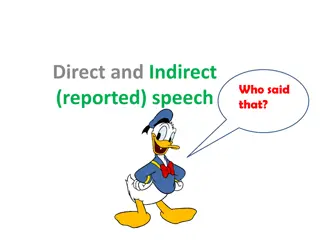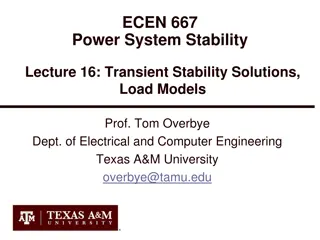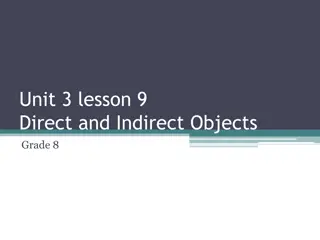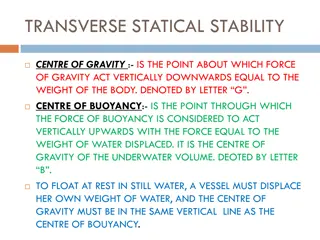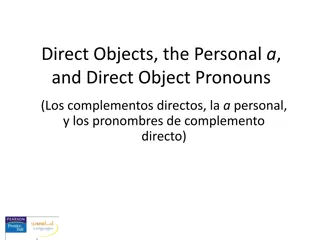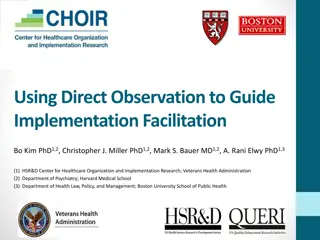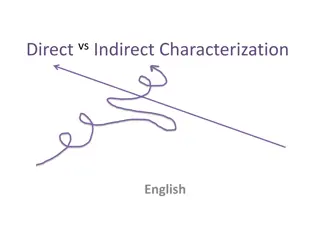Design for Stability - Direct Analysis Method CE 470 (Fall 2016) Saahastaranshu R. Bhardwaj
Stability in structural design is crucial for the safety and performance of compression members, elements, and frames. This content focuses on the Direct Analysis Method (DAM) as a rational approach to considering stability in structural engineering. Factors influencing stability, second-order effects, and analysis requirements for axial, flexural, and shear deformations are discussed, emphasizing the importance of rigorous analysis for structural stability.
Download Presentation

Please find below an Image/Link to download the presentation.
The content on the website is provided AS IS for your information and personal use only. It may not be sold, licensed, or shared on other websites without obtaining consent from the author.If you encounter any issues during the download, it is possible that the publisher has removed the file from their server.
You are allowed to download the files provided on this website for personal or commercial use, subject to the condition that they are used lawfully. All files are the property of their respective owners.
The content on the website is provided AS IS for your information and personal use only. It may not be sold, licensed, or shared on other websites without obtaining consent from the author.
E N D
Presentation Transcript
Design for Stability Direct Analysis Method CE 470 (Fall 2016) Saahastaranshu R. Bhardwaj
HOW WILL YOU DESIGN?? 2 Saturday, September 14, 2024
STABILITY the capacity of a compression member, element, or frame to remain in position and support load, even if forced slightly out of line or position by an added lateral force (Galambos, 1998) Figure from NASCC: The Steel Conference 2014, Session N40, Geschwindner 3 Slide from Dr. Liu s presentation Saturday, September 14, 2024
AISC DESIGNFOR STABILITY Stability to be provided for structure as whole, and each elements. Discusses the effects that need to be considered Any rational method considering these effects can be used Methods identified Chapter C: Direct Analysis Method (DAM) Appendix 7: Alternative Methods (effective length method & first order analysis methods) subject to constraints 4 Saturday, September 14, 2024
5 FACTORSTHATINFLUENCESTABILITY Member, component, and connection deformations Second-order effects (P- and P- ) Geometric imperfections (out-of-plumbness or out- of-straightness) Stiffness reductions due to inelasticity (residual stresses) Variability in component and system stiffness 5 Slide from Dr. Liu s presentation Saturday, September 14, 2024
SECOND ORDER EFFECTS 6 Slide from Dr. Liu s presentation Saturday, September 14, 2024
CHAPTER C DAM: ANALYSIS REQUIREMENTS Consider axial, flexural, and shear deformations in members, and connection deformations: accounted for directly by analysis Consider second order effects: perform rigorous analysis or use approximate method in Appendix 8 All loads influencing the stability need to be considered. For LRFD, use combinations. For ASD, use 1.6 times the combinations for analysis, divide the demands by 1.6 7 Saturday, September 14, 2024
SECOND ORDER ANALYSIS Rigorous non-linear analysis in the software considering second order effects Approximate second order analysis (Appendix 8) Multipliers B1 and B2 to consider the second order effects 8 Saturday, September 14, 2024
CHAPTER C DAM: INITIAL IMPERFECTIONS Directly model the imperfections Use Notional Loads 9 Slide from Dr. Liu s presentation Saturday, September 14, 2024
CHAPTER C DAM: INITIAL IMPERFECTIONS 10 Slide from Dr. Liu s presentation Saturday, September 14, 2024
CHAPTER C DAM: STIFFNESS Reduce stiffness contributing to stability by 20% Further reduce flexural stiffness by a factor ??, depending of the ratio of axial compression demand and yield strength 11 Saturday, September 14, 2024
CHAPTER C DAM: AVAILABLE STRENGTHS Provisions of Chapters D, E, F, G, H, I, J, K. Effective length, K=1 12 Saturday, September 14, 2024
5 FACTORSTHATINFLUENCESTABILITY (DAM) Member, component, and connection deformations: addressed directly in analysis Second-order effects (P- and P- ) : rigorous second-order analysis or first-order with B1-B2 Geometric imperfections (out-of-plumbness [notional loads or direct modeling] or out-of- straightness [column design equations; and reduced stiffness for effect on structure stiffness] 13 Slide from Dr. Liu s presentation Saturday, September 14, 2024
5 FACTORSTHATINFLUENCESTABILITY (DAM) Stiffness reductions due to inelasticity (residual stresses) : column design equations; and reduced stiffness for effect on structure stiffness Variability in component and system stiffness: in resistance and safety factors! 14 Slide from Dr. Liu s presentation Saturday, September 14, 2024
APP. 7 EFFECTIVE LENGTH METHOD (ELF): LIMITATIONS Gravity loads supported primarily by vertical columns, walls or frames 2 ????? 1 ????? 1.5 15 Saturday, September 14, 2024
APP. 7 EFFECTIVE LENGTH METHOD (ELF) Required Strength: Analysis same as for DAM, except stiffness reduction is not applied. Notional load is applied, second order analysis is performed. Available Strength: with provisions of Chapters D-K. K needs to be calculated for each case Alignment charts provided in the commentary can be used 16 Saturday, September 14, 2024
17 Saturday, September 14, 2024
COMPARISON 18 AISC C-C2.3 Saturday, September 14, 2024
HOW WILL YOU DESIGN?? 19 Saturday, September 14, 2024
DIRECT ANALYSIS METHOD: EXAMPLE SAP 2000 is used to analyze the frame shown below, using the provisions of Chapter C. 20 Saturday, September 14, 2024
DAM EXAMPLE: ASSUMPTIONS The loads provided are factored loads from combinations Self-weight is included in the loads provided Since there is a lateral load applied, notional load is considered in one direction 21 Saturday, September 14, 2024
DAM EXAMPLE: PROCEDURE Check if the software to be used considers the P- and P- effects This is done using the benchmarking problems provided in the commentary to Chapter C An elastic first order analysis is performed, then a second order analysis based on Chapter C is performed The results of both the analysis are compared 22 Saturday, September 14, 2024
DAM EXAMPLE: BENCHMARKING 23 Saturday, September 14, 2024
DAM EXAMPLE: ELASTIC ANALYSIS The frame is modeled with W shapes chosen according to the section properties in problem (Beam section: W 27x84 , Column Section: W 10x45). Linear Static Loading category is selected and the given loads are applied. Model is analyzed and member forces and story drifts are noted. 24 Saturday, September 14, 2024
DAM EXAMPLE: NON-LINEAR ANALYSIS The Loading is changed to Non-Linear static category and P- effects are selected (to take care of second order effects). P- effects are considered by creating nodes along the length of the members. The top ends of columns are offset by H/500 (to take care of initial out-of plumbness, instead of applying notional load). Notional load can be applied by selecting notional loads from More submenu under Load patterns. 25 Saturday, September 14, 2024
DAM EXAMPLE: NON-LINEAR ANALYSIS The stiffness of all beam columns is reduced by 20% by using area and inertia reduction factors (to take into account the residual stresses in the elements). Can also be done by reducing E value (will need to be changed again if design is performed by the software) For central column, Pr > 0.5 Py . Hence, its flexural stiffness needs to be further reduced by ??. Instead of doing this, an additional Notional Load of 0.1% of the Gravity Load is applied at the corresponding locations of the gravity loads (SAP has option to automatically calculate ??, but one needs to design and then go back and analyze again). Model is analyzed and member forces and story drifts are noted. 26 Saturday, September 14, 2024
DAM EXAMPLE: COMPARISON 27 Saturday, September 14, 2024
DAM EXAMPLE: CONCLUSION The moment magnification is of the order of 2.5. This is due to high magnitude of forces being applied. The second order drift is about three times the first order drift. When designed, it is observed that the member demands (considering second order effects) exceed the member design strengths. 28 Saturday, September 14, 2024
THANKS!! 29 Saturday, September 14, 2024







